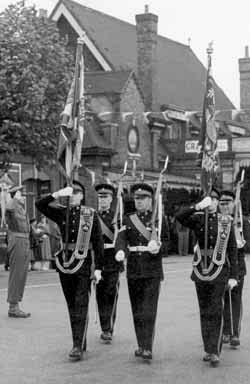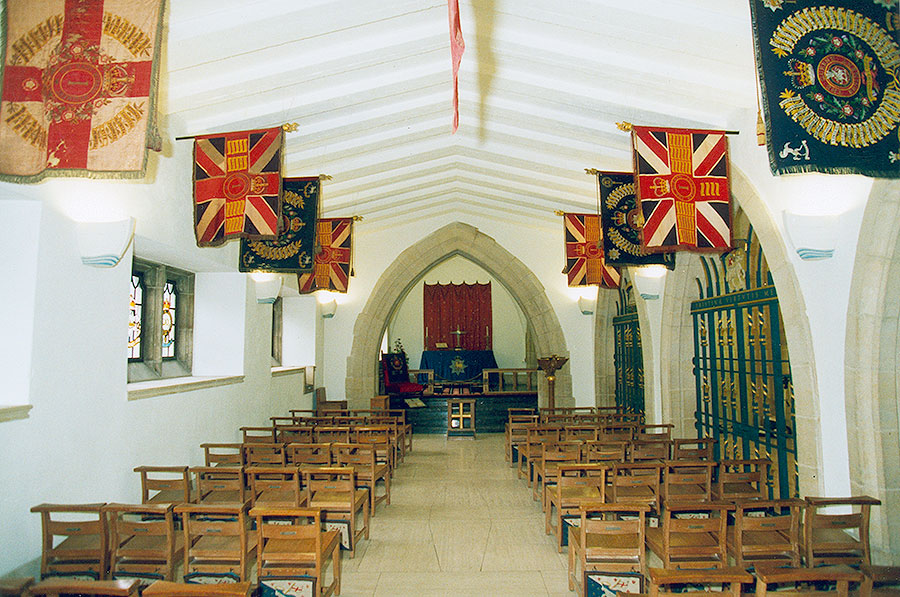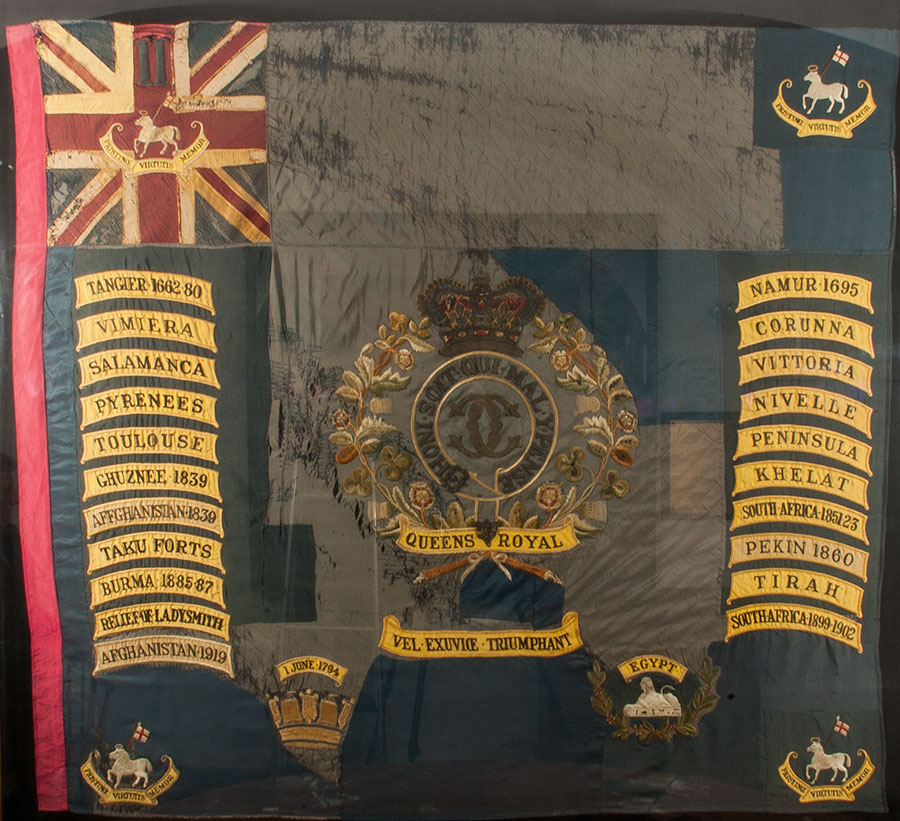Historical Note On The Use Of Colours
Many changes have taken place since these notes were published and a number of the regiments have ceased to exist, or have suffered many amalgamations.
1 The British Regular Army dates from the Restoration. The object of this is to trace, briefly, the purpose of its colours over the past three hundred years.
 |
| 1st Bn The Queen's Royal Regiment Coronation Colour Party, leaving Guildford Railway Station. 2nd/Lt P S Field, C/Sgt J Norman, 2nd/Lt P M Stamper, C/Sgt J Rodgers, Sgt W Redford. (Note Joe Norman is now, May 2002, an In- Pensioner at The Royal Hospital Chelsea). |
Early History
2. Although the Army dates its formation from 1661, the practice
of carrying Colours continues back through the Royalist and Cromwellian
Armies, when the hue of a Colour corresponded to the title of
a unit (e.g. the Red Regiment carried a red Colour). In 1639 it
was written of the "office and duty of a Colonel of a Regiment
that “hee ought to have all the Colours of his Regiment
to be alike in colour and fashion to avoide confusion so that
the souldiers might discern their own Regiment from the other
troopes”. In the Middle Ages, when much of a soldier's
body was covered in armour, identification was achieved only by
leaders using their coats of arms, or heraldic designs upon shields
and on pennons or banners carried from the shaft of the lance.
It is clear, therefore, that on the formation of the Standing Army the purpose of Colours was essentially a practical one, i.e. to assist identification,
The Warrant of 1747
3. The practice of using. Colours to carry the armorial bearings
of a leader continued for almost a hundred years, In 1747 however,
a Warrant established that “no Colonel to put his Arms,
Crest, Device or Livery on any part of the appointments under
his command” and “that the second Colour (i.e. the
Regimental Colour) be of the same colour as the facings of the
Regiment and to bear the Regimental Number”.
At this time “facings” comprised the lapels, cuffs and turnback of the coat. The Colours were still being used therefore as a means of identification and this practice of carrying the Regimental Number on the Regimental Colour continued until 1881 when the Numbers were replaced by the new Territorial titles.
Colours in Battle
4. The Colours were carried in the centre of the front rank where
they could be easily seen and recognised. Their presence in the
battle undoubtedly had a high morale effect and once battle was
joined, the Colour Party became an obvious target and the centre
of the most bitter hand to hand fighting. The rate of mortality
amongst Ensigns was high; for .the importance of a victory was
generally gauged by the number of guns and stands of Colours that
were captured.
With a view to giving the Ensigns some local protection, the rank of Colour Sergeant was introduced in 1813. “It is His Royal Highness' pleasure that the duty of attending the Colours in the field shall at all times be performed by the Sergeants” and “that they shall bear above their chevrons the honourable badge of the Regimental Colour supported by two crossed swords”.
5. Writing of Waterloo, Sergeant William Lawrie, 40th Regiment, says: “About 4 o'clock I was ordered to the Colours; this, although I was used to warfare as much as anyone, was a job I did not at all like. But still I went as boldly to work as I could, There had been before me that day 14 Sergeants already killed and wounded and the staff and Colours almost cut to pieces”.
6. Although the carrying of Colours in battle involved considerable loss of life amongst those who bore them, the practice continued until comparatively recent times. such were the losses amongst Colour parties in the Crimea that in the later battles of that Campaign some Commanding Officers ordered their Colours to the rear once battle had been joined. At the disaster of Isandhlwann, 1879, two subalterns received posthumous Victoria Crosses for their endeavours to save the Colours and from this date the practice of carrying Colours in battle gradually came to an end. They were last carried in battle at Laings Nek in 1881.
 |
| View of the Chapel looking towards the altar (Click to enlarge) |
Battle Honours on Colours
7. The system of placing battle honours on Colours did not start
generally until after the Peninsular War. As a mark of Royal Favour,
certain Regiments had been authorised to place a badge, (e.g.
the White Horse of Hanover or the current Royal Cipher) on their
clothing and appointments, including the Colours.
Between 1661 and 1812 however there were three solitary instances where a battle honour was placed on a Colour. The first occurred in 1768, when as a result of a spirited cavalry action, Eliott's Light Dragoons (later 15th Hussars) were authorised to place the word EMSDORF on their helmets and on their Guidons.
The next instance occurred in 1784, when the four Regiments which had taken part in the Siege of Gibraltar were permitted to place the word GIBRALTAR upon their Grenadier and Light Infantry caps, their accoutrements, and drums, and likewise upon the Colours.
After a lapse of 18 years those regiments which had fought in Egypt in 1801 were authorised to place a sphinx with a wreath of laurel and the word EGYPT on their appointments, including the Colours.
 |
| 1st Bn The Queen's Royal Regiment, Regimental Colour 1837-1847,
now in the Regimental Museum at Clandon. (Note the different spelling of the Battle Honour AFGHANISTAN). (Click to enlarge) |
Rifle Hussar and Lancer Regiments
8. An experimental Rifle Corps was raised in 1801. Their role
was a skirmishing one in open order. Concealment was important
and there was thus no necessity for the use of Colours. The experimental
Rifle Corps ultimately became the Rifle Brigade and as the experiment
proved successful other Regiments were converted to a Rifle role,
for example the 60th Regiment was converted in 1824 and from that
date ceased to carry Colours. Four other Regiments were subsequently
converted.
They are now amalgamated into the Cameronians (Scottish Rifles) 2nd the Royal Ulster Rifles, and they also on conversion gave up carrying Colours. Certain Light Dragoon Regiments were converted to a Hussar role in 1807. The role of Hussar was considered analogous to that of a Rifle role and accordingly these Regiments gave up carrying Guidons. This was eventually confirmed by an Order of 1834. Other Light Dragoon Regiments were converted to a Lancer role at varying dates from 1815 onwards and they also, on conversion, gave up carrying Guidons.
It is clear that the original purposes of Colours were to aid identification and to act as a guide and a rallying point in battle. They were a part of the appointments of a Regiment; battle honours as they were gradually introduced were placed not solely on the Colours but on the clothing and other appointments such as drums and bells of Arms.
The history of many of our Regiments is bound up with deeds of considerable heroism around the Colours. The willingness of so many to grasp the Colours when others had fallen and unhesitatingly accepting risks far beyond those normally occurring in battle constituted examples of self sacrifice of the highest order. Since 1804 Colours have been entitled to the highest Military honours. The reason why Colours are carried by some Regiments and not by others is clear, and depends on their role in the past. It may be argued that as there is no difference, now, between the role of Dragoon Guards and Lancers then, therefore there is no reason why the latter Regiments should not now bear Guidons again.
These Regiments who now carry Colours have done so continuously from the date of their formation almost without exception. Care must be taken that the Honour and Sanctity of these Colours does not change through a wholesale adoption of Colours, throughout the Army, occasioned by a desire to display Battle Honours, which could equally be borne in other ways as they have been in the past.
Related
